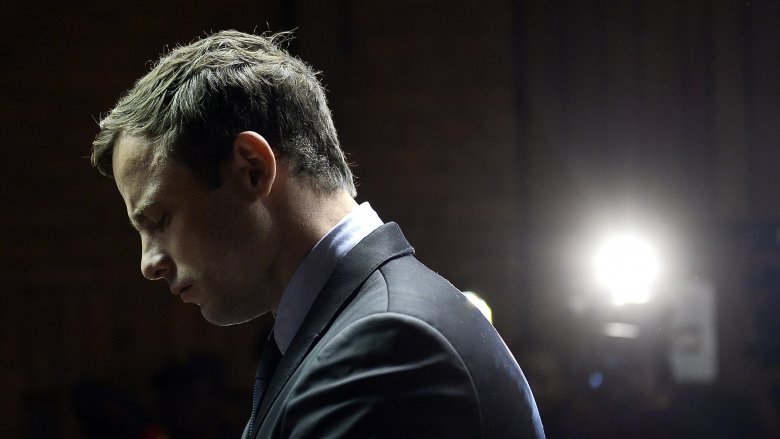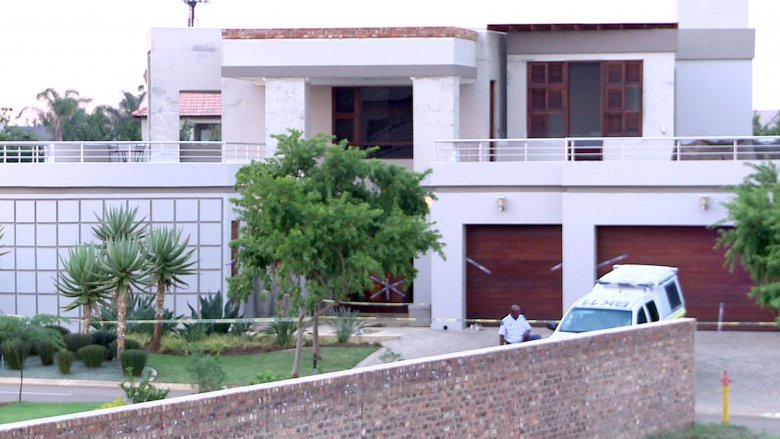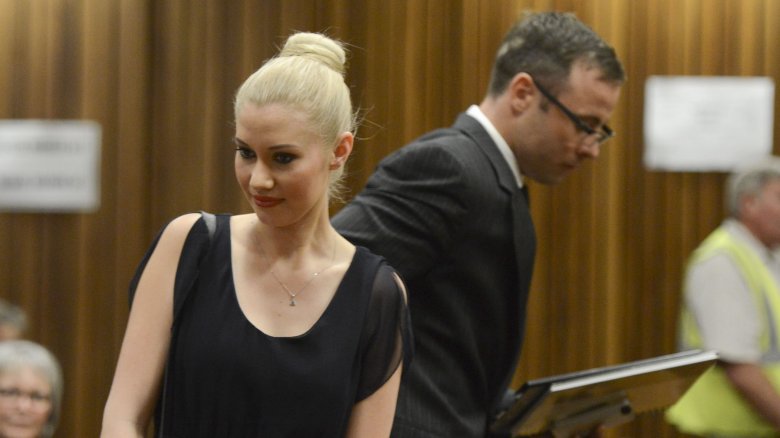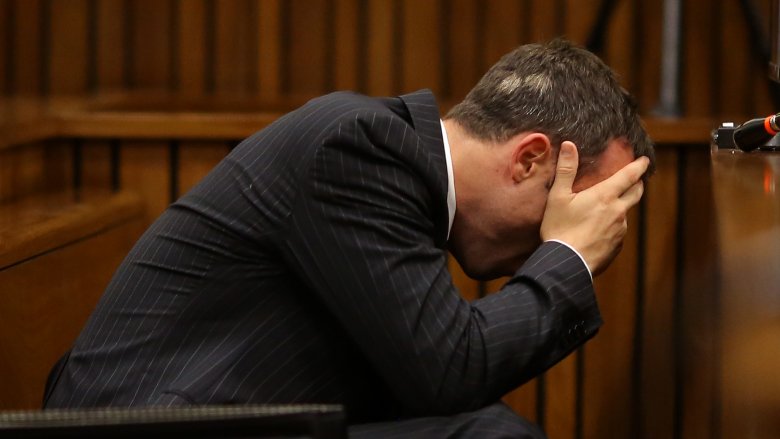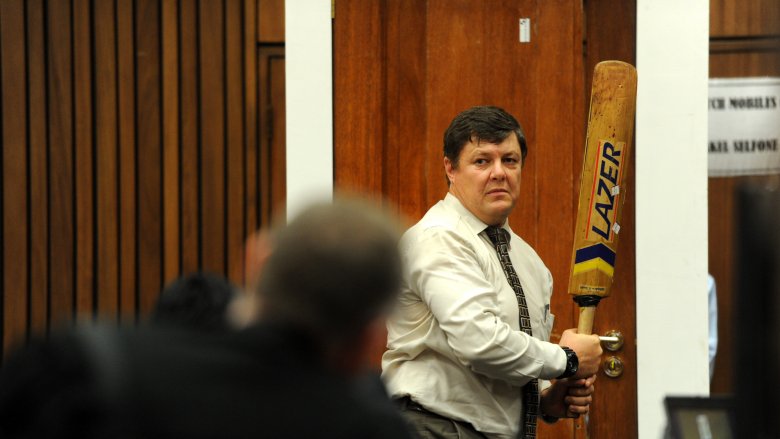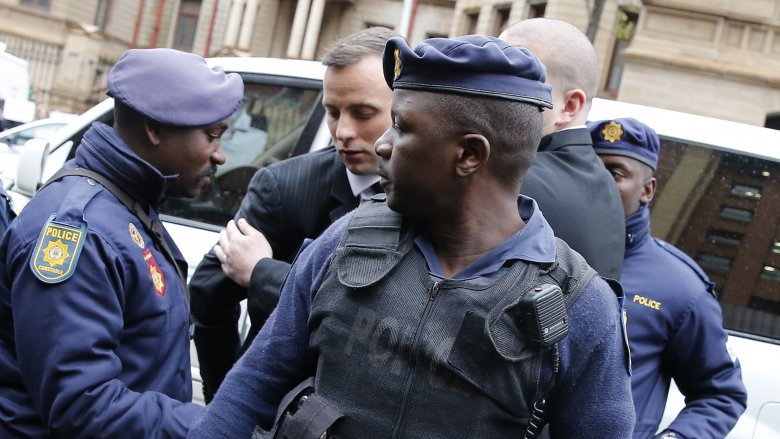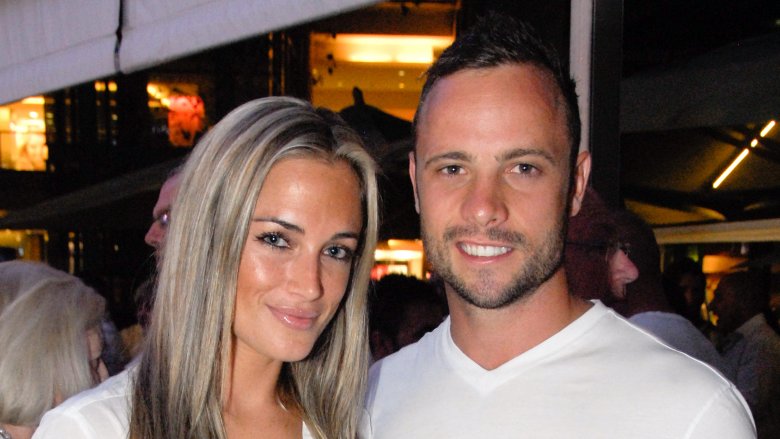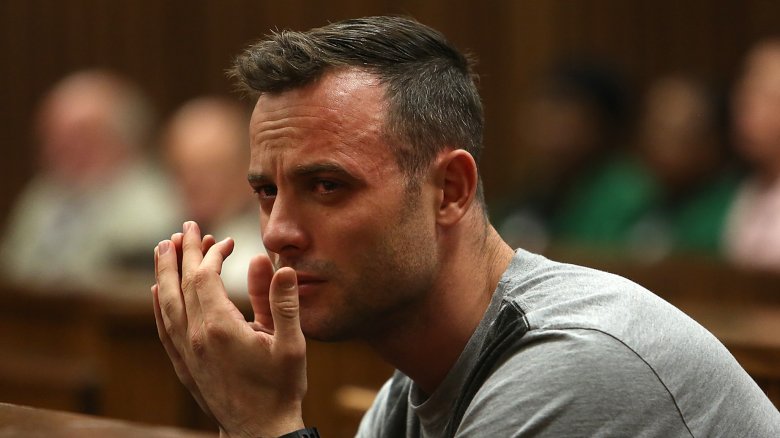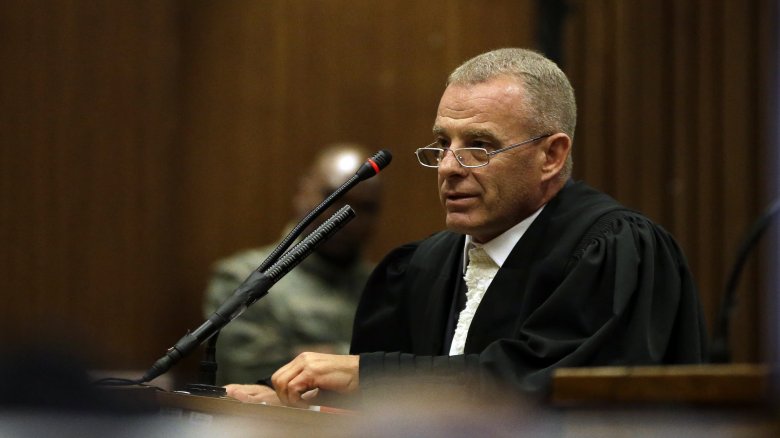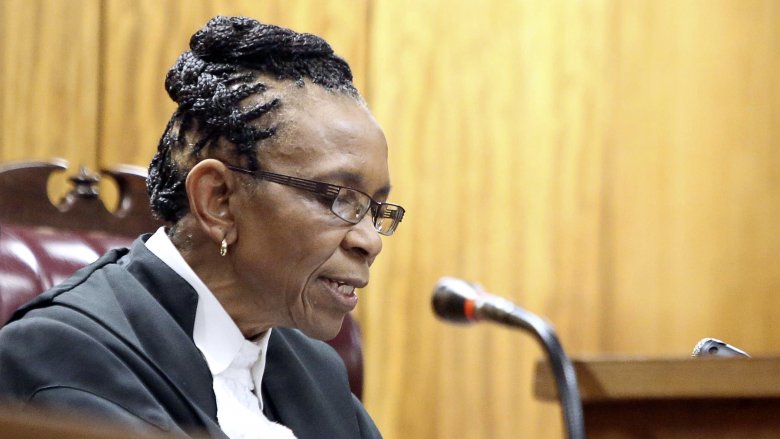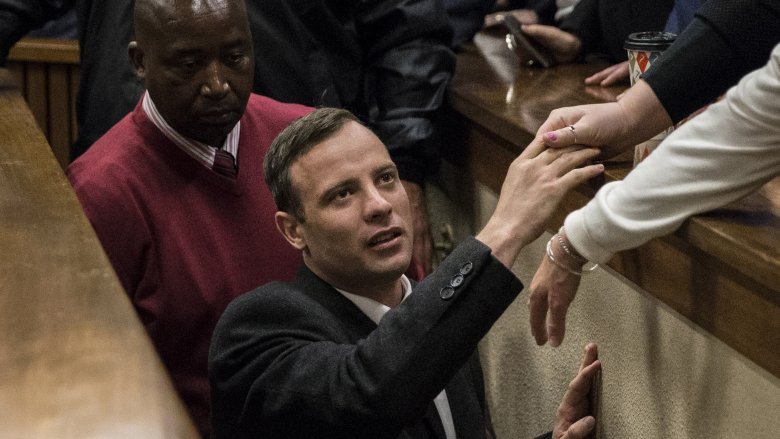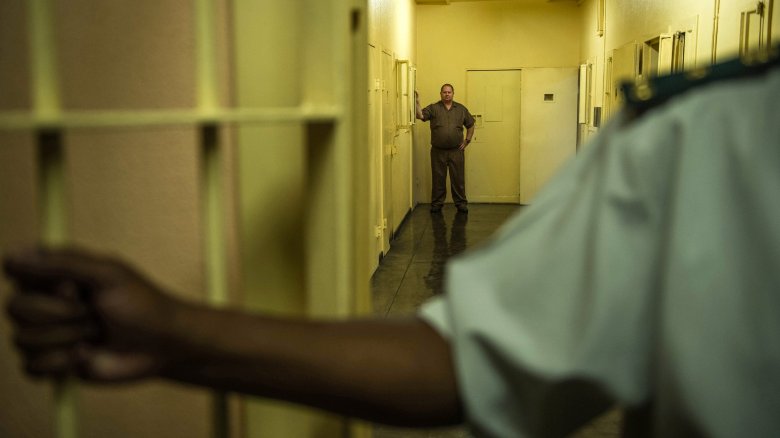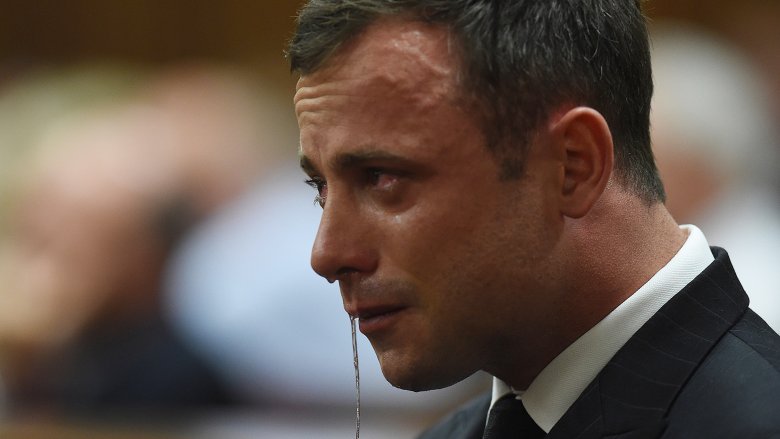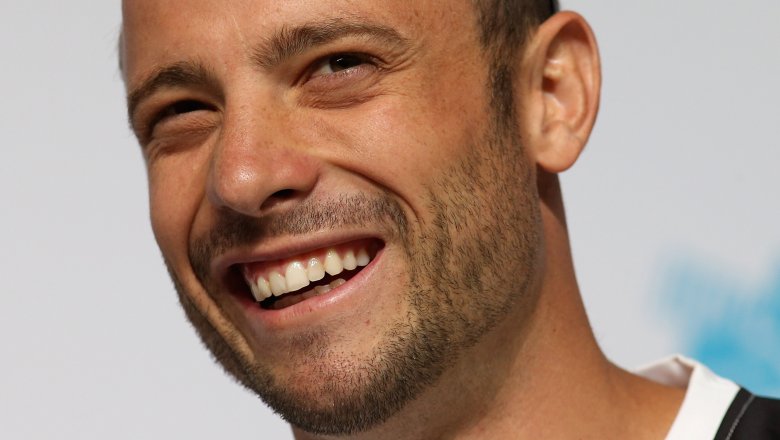The Untold Truth Of The Oscar Pistorius Trial
Paralympian Oscar Pistorius shot to global stardom with his heroics at London 2012, becoming affectionately known across the world as the Blade Runner. The South African sprinter was born without calf bones and had his legs amputated below the knees aged just 11-months, allowing him to be fitted with prosthetics that would not only allow him to walk, but also make history by becoming the first ever disabled runner to compete in the Olympic Games. The reputation he built for himself came crashing down just months later, however, when he shot his girlfriend Reeva Steenkamp dead on Valentine's Day.
Pistorius fired four shots through his bathroom door on that night in 2013, hitting Steenkamp with three of them. While he maintained that he woke up to noises in the cubicle and thought they were being robbed, there were parts of his story that weren't adding up. The world became transfixed with his trial, watching in horror as in the gory details of what went down on that secluded Pretoria estate were broadcast on news stations everywhere.
A casting call was recently put out for a Hollywood movie based on his life so it looks as though the disgraced athlete will be back in the headlines soon, and this is your chance to get ahead of the curve—here is the untold truth of the Oscar Pistorius trial.
His neighbors heard 'bloodcurdling screams'
Pistorius' neighbors Charl Johnson and Michelle Burger testified that they heard four gunshots and "bloodcurdling screams" on the night that Steenkamp was shot dead. The couple chose to reveal what they knew through a lawyer rather than contacting police, realizing the following morning that they would be involved in a case that would be covered by every major news station around the world. With their faces off-camera, they described hearing what they thought was a robbery and said they were shocked when they found out the blonde model had been killed.
Burger broke down as she explained how she heard terrifying noises coming from Pistorius' home, while Johnson confirmed they were coming from two people. "We heard a male and female voice," he said. "We thought maybe the attackers had gone and left a husband and wife tied up. I remember during the succession of shots I heard a lady scream again, and shortly after the last shot." A third neighbor named Estelle van der Merwe corroborated what they heard, telling the court how she woke to hear an argument and loud bangs that night.
He had previous offenses with firearms
On top of murder, Pistorius was also being tried for firearms offenses after an incident in which he accidentally fired a gun inside a packed restaurant and asked his friend to take the blame. Professional boxer Kevin Lerena explained to the court how he almost lost a toe when Pistorius fired the weapon after being handed it under the table by a man named Darren Fresco without a warning that it was loaded.
"A shot went off in the restaurant," Lerena said. "Then there was complete silence. I looked down. I was in shock. Where my foot was, I saw a hole in floor." When restaurant owner Jason Loupis came over the investigate, it was Fresco, not Pistorius, who took the blame. "I heard a loud bang which I thought could have sounded like a gun but I was hoping not," he told the court. "I said 'Guys, what happened here?' They all looked at me. Darren said 'Sorry Jason, my gun fell out of my pants.'"
There were around 220 people eating in Loupis' restaurant at the time, which did not paint Pistorius in a good light, though it was the video that emerged of him showing his prowess with guns that really made him look bad. "It's a loft softer than brain," he can be heard saying after blowing a watermelon to pieces, "but f***, it's like a zombie stopper."
His ex-girlfriend came forward with harrowing stories
Pistorius' ex-girlfriend Samantha Taylor took to the stand to drive home prosecution accusations that the sprinter was volatile and trigger-happy, telling the court that he once fired his gun out of a sunroof after the car he was in was stopped by police. Taylor also revealed that Pistorius' relationship with Steenkamp began when she was still dating the star athlete, casting more shade on his character in the eyes of the public. It wasn't until after court adjourned that she lifted the lid on their "angry and possessive" 18-month relationship.
"What happened to Reeva Steenkamp could so easily have happened to me," she told Mirror. "I definitely think that could have been me, without a doubt." Taylor (who was barely out of her teens at the time) also explained how she had to hide her ex-boyfriend's gun after he threatened to use it on her while drunk. "He was on the hard liquor. He slipped and he chipped his tooth, but because he was so drunk he thought I'd beaten him up. He started screaming at me. He was looking for his gun. When I got to the room I hid his gun, because I really did think he'd use it."
He was violently sick in court
On the sixth day of the trial, judge Thokozile Masipa deemed the evidence that was about to be heard too graphic for broadcast and banned live coverage of proceedings. The public would later learn that the contents of Steenkamp's pathology report were so disturbing that Pistorius became violently sick as it was read aloud to the court, vomiting in the dock. He continued to retch as professor Gert Saayman (who performed the autopsy on Steenkamp) revealed his grisly findings, including the devastating effect of the "black talon" bullets that the visibly shaken defendant used.
"The usual result is it folds out like the petals of a flower," Saayman said. "They were specifically designed by the manufacturer to have very sharp jagged edges. This projectile was designed to cause maximum damage." The professor told a shocked court that Steenkamp was hit in the arm, hip and head, with the latter wound likely to have been almost instantly fatal. "The deceased probably didn't breathe more than a few times after sustaining this wound," he said.
The OJ-style 'if the glove does not fit' moment
Lead prosecutor Gerrie Nel soon started trying to poke holes in Pistorius' story, cranking up the heat when he brought in a forensics expert to examine a full reconstruction of the bathroom Steenkamp died in, including the actual door that she was shot through. Experienced investigator Colonel Gerhard Vermeulen got to his knees with the same cricket bat Pistorius used to break down the door after firing and showed how the marks must have been made when he was without his prosthetics, not wearing them as the track star claimed.
The demonstration didn't all go to plan, however. In a moment Guardian described as a potential "OJ-style 'if the glove does not fit' moment," Pistorius defense advocate Barry Roux asked Vermeulen to kneel and stand on his toes before swinging, recreating how a double amputee such as Pistorius would feel swinging a bat—off balance. Vermeulen wobbled as he attempted to swing the bat, bringing his assertions into question. Roux was able to cast more doubt on the forensic findings when he proved that police stepped all over the door during the investigation (there was photo evidence of footprints that were later wiped away).
The police stole jewellery from the crime scene
Roux would continue to channel Johnny Cochran as he pointed to more errors on the part of the police that evening, who not only mishandled what they later called the most important piece of evidence (the bathroom door), but also jeopardized the murder weapon through sheer incompetence. Former police colonel Schoombie van Rensburg was one of the first on the scene that night, and he told the court in no uncertain terms that he was he horrified to see the 9mm pistol being handled.
"At that particular moment the ballistics expert was handling the firearm without gloves," van Rensburg admitted. "I was busy talking on my cellphone when I heard the firearm had been cocked. I stopped talking and said, 'What are you doing?' He said sorry and put the magazine back in the firearm... So immediately I was very angry." The court also heard how two wristwatches worth 50,000-100,000 rand ($3,900-$7,800) went missing even after van Rensburg explicitly warned his officers against pocketing any of Pistorius' fancy personal possessions.
His WhatsApp messages revealed a volatile relationship
Despite scoring points by highlighting the many failings made by the South African police on this occasion, Roux found his defendant up against the ropes when the contents of his WhatsApp conversations with the late Miss Steenkamp were shown to the court. The accused sat with head in hands as messages sent just weeks before the killing were read aloud in front of both families and the millions watching around the world.
"You have picked on me excessively," a message from Steenkamp sent on January 27, 2013 read. "I do everything to make you happy and you do everything to throw tantrums. I'm scared of you sometimes and how you snap at me and of how you will react to me." Steenkamp's unhappiness at being publicly humiliated by Pistorius at a public event was also exposed in messages recovered from her phone, as was an argument over her time on reality TV show Tropica Island of Treasure, in which he questioned her over her behavior. "I wasn't a stripper or a ho," she said.
He was on porn sites hours before the shooting
Despite those nasty exchanges between the pair, police mobile phone expert Francois Moller told the court that 90 percent of what he was able to pull from the late model's cell were "normal conversations and loving conversations." While defense advocate Roux was able to run with that to some extent, his attempts to convince the court that Pistorius and Steenkamp were deeply in love took a blow when the defendant's internet search history from that bloody Valentine's evening was exposed.
It turned out that the revered runner had been searching for hardcore pornography online only hours before shooting his lover dead, entering Google searches for "free mobile porn" and "iPad porn" as well as browsing some car websites. According to Colonel Mike Sales (another tech expert) Pistorius accessed at least one pornographic video streaming website and continued to make searches for such sites on a tablet device between 6:29pm and 9:19pm. Steenkamp had arrived at his home for their date at 6:00pm.
The witnesses the prosecution ignored
While Nel accused Pistorius of lying and feigning emotional distress to dodge hard questions during his gruelling cross examination, the lead prosecutor himself came under scrutiny for failing to question some of the witnesses that were first on the scene that night. Neighbors John Stander (the administrator of the Pretoria estate where Pistorius lived) and his daughter Carice Viljoen arrived at the athlete's house after receiving a call from him asking them for help.
When they got to the address, Pistorius was carrying Steenkamp's bloodied, lifeless body down the stairs. "He was broken," Stander told the court. "He was screaming, he was crying, he was praying ... He was desperate to save her [and] prayed to God." Stander (whom Pistorius calls 'Oom', Afrikaans for 'Uncle') stated he believed his long-time neighbor's version of events. "I saw the truth that morning and I feel it," he said.
Viljoen gave a similar account to that of her father, painting Pistorius as a man utterly shattered by what had taken place moments earlier. She told the court that when authorities arrived and told Pistorius to fetch Steenkamp's ID, she worried what he might do. "I was scared that he might shoot himself," she said.
He had to undergo 30 days psychiatric evaluation
With the trial on a knife-edge, Roux decided that the best way to defend Pistorius going forward was to highlight his mental state at the time of the shooting to distract from the poor performance he gave under questioning from prosecutor Gerrie Nel. That was the argument Nel made to Judge Thokozile Masipa when opposing the idea that Pistorius should undergo 30 days of psychiatric evaluation to assess whether he was criminally responsible for what happened, but she agreed with the defense and allowed the celebrity to cut a huge waiting list for a spot in Weskoppies hospital.
After defence witness and forensic psychiatrist Dr. Merryll Vorster told the court that she had doubts over Pistorius' ability to distinguish right from wrong, Masipa acted. The veteran judge said that a panel of mental health professionals had been asked to "establish whether the accused was by mental illness or defect criminally responsible for his actions [and] also seek to establish whether Mr Pistorius was capable of appreciating the wrongfulness of his act, or of acting in accordance with an appreciation of the wrongfulness of his act."
He almost got away with murder
Pistorius was diagnosed with depression and posttraumatic stress disorder in the psych reports, and that, coupled with the judge's opinion that the state had failed to prove beyond a reasonable doubt that he meant to kill whoever was behind that door, meant that the murder charges were dropped. Instead, Masipa found the shamed celeb guilty of the lesser charge of culpable homicide, shocking Steenkamp's family and the rest of the world. "He shot through the door and I can't believe that they believe it was an accident," Reeva's mother June Steenkamp told ABC (via BBC), while her father Barry said that justice had not been done. Apparently, South Africa's Supreme Court of Appeal agreed.
With the South African legal system under heavy scrutiny domestically and around the world, the country's highest court decided to upgrade Pistorius' conviction to murder, carrying a maximum sentence of 15 years. In the end, the same judge that originally dismissed murder charges handed down a new sentence of 6 years jail, with the possibility of parole in half that time. The prosecution welcomed the recognition of murder but called the new terms of his imprisonment "disproportionate" and "shockingly too lenient."
He was threatened with gang rape
Soon after news that Pistorius was going down for murder got out, the fallen hero's family began receiving death threats and were forced to up their own security out of fear of vigilante retribution. A message from notorious leader of the 26s gang Khalil Subgee (known in the South African underworld as The General) got to the media after the new verdict, with the mob boss allegedly ready to put a hit out on Pistorius if he attempted to exploit his fame to gain favor in his prison. But perhaps the most chilling threat to the Pistorius family came from an unknown number.
Using WhatsApp, an anonymous blackmailer claiming to have knowledge of under-the-table payments that took place during the trial, contacted Pistorius' cousin. When she ignored the demands, the reply shocked her. "When Oscar returns to jail I will ensure that he is gang raped, also he will suffer and I will have my man beat him properly," the message read. "Your children will be murdered as well."
Pistorius had already spent a year behind bars on his culpable homicide sentence by this point, and in those 12 months he claims to have had his eyes blackened by a fellow inmate and witnessed another being raped before committing suicide.
He was put on suicide watch after cutting his wrists
Mental health experts warned that Pistorius was at risk of suicide going forward, and according to City Press (via Daily Mail) that prediction was correct. Ah jail insider revealed that an incident began when Pistorius refused to take pills prescribed by the state out of fear that they were trying to kill him. The most famous inmate housed in Pretoria's Kgosi Mampuru II prison is said to have lodged a complaint against the nursing staff for attempting to "murder him with toxic medicine" and became distressed about his treatment one night. Staff found him bleeding in his cell with "severe" injuries to his wrist, and while they managed to save his life, he was quickly placed on suicide watch when razor blades were discovered.
He denied that he made an attempt at his own life, blaming the cuts on a simple accident. "Pistorius claims he had taken a sleeping pill and went to bed as normal, but got up in the night to use the toilet in his cell," a MailOnline source revealed. "He claims he slipped in some leaked water, lost his balance and fell against a drawer, cutting his lower forearm." While it is possible that Pistorius simply fell, the fact that this injury happened just as the 2016 Olympics were getting underway in Brazil casts undeniable doubt on his story.
He now lives comfortably in a new facility
After earlier requests to be moved to a more suitable facility fell on deaf ears, the state relented after the suicide scare and Pistorius was eventually sent to Atteridgeville Correctional Centre, a new low-security facility surrounded by lush greenery with 7,000 less inmates. He will serve the rest of his time here in relative luxury compared to conditions in the overcrowded institution he came from. "There are some worthwhile programmes of all kinds on offer and some amazing things are happening for him," a family insider told Daily Mail about the move. "He is in the ideal place for where he needs to be at the moment."
A photograph of a bearded, barely recognizable Pistorius posing with his family was shared online in 2017, as they continue to support him through the upcoming state appeal to lengthen his murder sentence. If it fails, the Blade Runner could be out in a just a few years time, and he is said to have a "positive outlook" about his chances.

